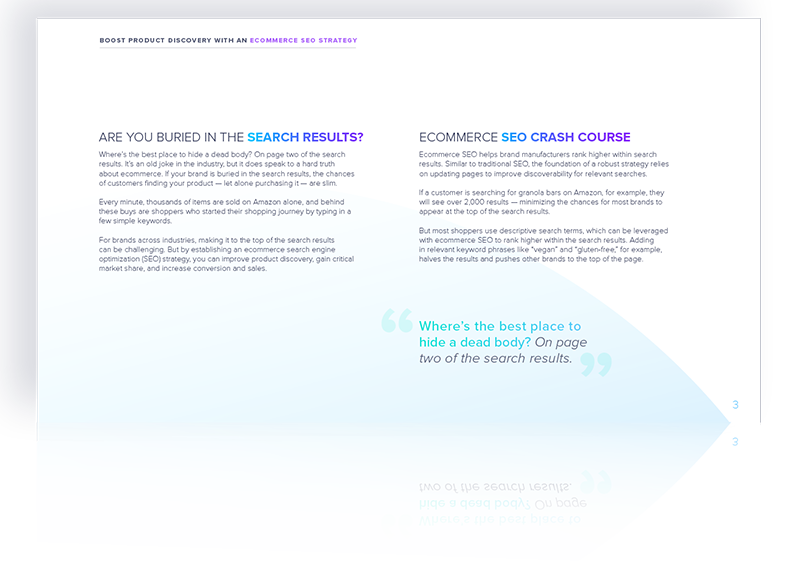8 Quick Ecommerce Tips for SEO for Product Pages
Written By: Doug Bonderud
Better search engine optimization (SEO) = More sales.
It’s a simple equation, backed by data. As noted by Reboot, at least 43% of all ecommerce traffic comes from Google organic searches.
According to Backlinko, meanwhile, the top result in Google gets more than 27% of all click-throughs. This number drops off sharply over the top 20 results, and just 0.63% of users even make it to the second page of search results.
This means that for your product pages to get noticed — and your sales volumes to increase — you need to rank as high as possible in search engine results.
But boosting SEO isn’t always easy; here are eight quick tips for performance-driving ecommerce SEO for product pages that can help your products get listed, seen, and purchased more often.
8 Quick Tips for SEO for Product Pages
Products and prices vary by brand. Regardless of your market or target audience, these eight tips can help boost your search ranking.
1. Utilize On-Page Optimization
Your product page content can make the difference between first-page results and second-page finishes. As a result, it’s important to optimize this content for maximum SEO impact.
Start with targeted keywords. These are keywords that align with audience search intent. For example, if you sell sports merchandise such as baseball jerseys, you could use keywords such as “[team] baseball jersey.”
The challenge? Shorter, generic keywords often have high search volumes, meaning you compete with hundreds or thousands of other brands. To help boost your SEO impact, try using long-tail keywords (those with three words or more) that have lower search volumes, such as “[team] retro away baseball jersey” or “[team] limited edition home baseball jersey.”
You can also optimize SEO for product pages by using keywords in title tags, meta descriptions, and headings. But make sure you don’t overdo it. Search engines can easily recognize keyword stuffing and your rank will fall as a result.
2. Create Engaging Product Descriptions
Product descriptions give you a chance to stand out from the crowd. Well-crafted descriptions can both boost search visibility and increase user engagement.
Keywords form the core of great product descriptions. As noted above, do your research to find mid-to-low volume keywords that align with your offering and can help you capture more market share.
Next is creating content that users want to read. While keywords are important, just getting your product page noticed isn’t enough to drive purchases.
To help boost page impact, start with tone. Are you aiming for funny? Knowledgeable? Authoritative? Quirky? The tone should align with what you’re selling and be consistent across product pages.
With keywords and tone in place, you’re ready to create content that showcases your product value. Start by highlighting your product features and translating them into benefits. So instead of “Our product has X feature,” write “X feature helps you [save time, reduce effort, etc.,].
It’s also important to support your claims. For example, if you say your product can do “X” better than the competition, include data to back this claim. If you don’t have the data, don’t make the claim.
3. Increase Image Impact
Images play a major role in product page SEO. Not only do they improve user engagement, but they can also be used to boost SEO.
Start by adding descriptive file names and alt text to your images. Where possible, include target keywords but don’t force them if they don’t fit.
Ensure your images are appropriately sized for product pages. Images that are too small won’t add value for users, while images that are too large will increase page loading times and decrease your SEO.
4. Build SEO-Friendly URLs
Your product page’s URL tells users and search engines what your page is about. As a result, it’s worth including a target keyword to help improve your page ranking.
Keep URLs short and simple; this lets users glean what the page is about at a glance. It’s also worth using hyphens to separate words in your URL.
For example, instead of a URL that says https://jerseyplace.com/retrobaseballteamjersey, it’s better to use an SEO-friendly version such as https://jerseyplace.com/retro-baseball-team-jersey.
5. Leverage Internal Linking
Wherever possible, use internal linking to improve SEO for ecommerce product pages. This could mean linking to similar products, new offerings, or relevant content such as a product manual.
A solid linking strategy can offer value for users and help boost your SEO since each search for each linked page will help boost your overall search ranking.
6. Implement Schema Markup
Also known as structured data, schema markup is a shared language used by search engines to understand the content on your product pages. Google, Microsoft, and Yahoo all use the same language (found at Schema.org) to process page data.
Put simply, adding schema to words on your product page provides information for search engines.
These schemas aren’t visible to users but can impact search results — pages with schema typically display more detailed information in search results, such as images or in-depth product information related to keywords.
7. Include User Reviews
Buyers trust other buyers. While they’re inclined to give you the benefit of the doubt, customers also know you’re trying to sell them something. Including user-generated content (UGC) on your product pages, such as reviews or links to articles about your products, will increase user trust.
You can also boost SEO, especially if you regularly update reviews. New reviews provide fresh content for search engines and often include relevant keywords, both contribute to improved search rankings.
8. Optimize for Mobile Devices
Last but not least: Don’t ignore mobile devices.
Consider recent data from Statista, which found that mobile ecommerce generated $2.2 trillion in U.S. sales in 2023. Pair this with the fact that Google now accounts for mobile performance when ranking sites, and it’s clear that mobile optimization is a priority for improving SEO.
Solving for SEO: Product Page Priorities
Product pages can make — or break — your search engine ranking. By improving SEO with keyword-rich product descriptions, SEO-friendly URLs, schema markup, and other enhancements that capture the attention of popular search engines, brands can boost customer engagement and climb the ladder toward the top search spot.

Boost Product Discovery With an Ecommerce SEO Strategy
Download our guide to learn how to boost product discovery and drive performance across the digital shelf.
DOWNLOAD NOWWritten by: Doug Bonderud
Doug Bonderud (he/him) is an award-winning writer with expertise in ecommerce, customer experience, and the human condition. His ability to create readable, relatable articles is second to none.
Recent Posts
Curated Commerce: How Shopping Apps Can Boost Sales
The State of Secondhand Shopping: Circular Commerce Trends and Consumer Insights
How To Kick Shopping Cart Abandonment to the Curb
Subscribe to the Below the Fold Newsletter
Standing out on the digital shelf starts with access to the latest industry content. Subscribe to Below the Fold, our monthly content newsletter, and join other commerce leaders.

.svg)